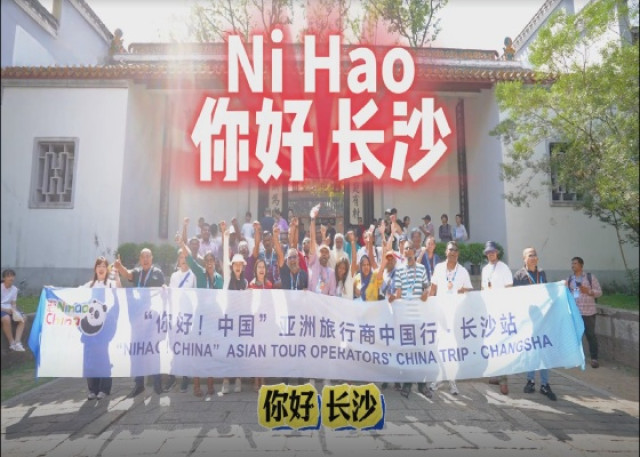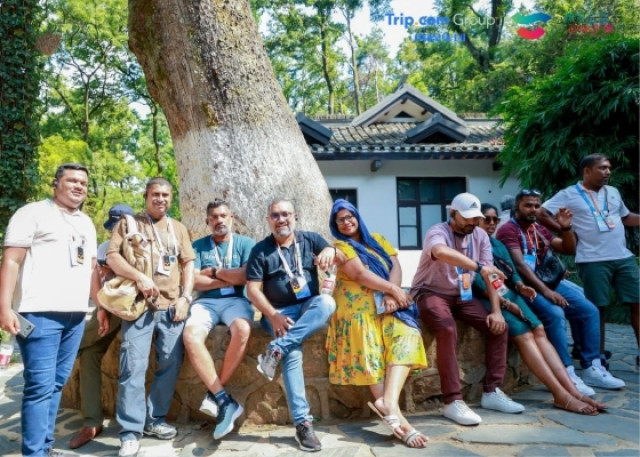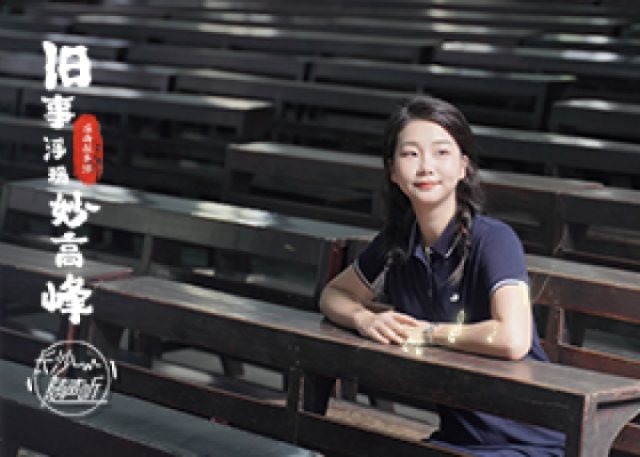想沉浸式體驗(yàn)漢代生活,?來(lái)湖南博物院看看,!

A naked-eye 3D screen brings to life elements from Mawangdui, a renowned ancient Chinese tomb. Visitors are captivated as civet cats with intricate fur and bright eyes leap out, finely crafted lacquerware showcases the artistry of ancient craftsmen, and various delicacies from the Western Han Dynasty (202 BC-25 AD) are vividly recreated through animation.
一塊裸眼3D屏幕讓馬王堆漢墓里的古典元素“活”了起來(lái),。毛發(fā)纖細(xì)、眼睛明亮的靈貓生動(dòng)躍出,,制作精巧的漆器彰顯古代工匠的高超技藝,,還有來(lái)自西漢時(shí)期的各類美食佳肴……隨著一組組動(dòng)畫(huà)的精彩呈現(xiàn),游客們無(wú)不沉浸其中,。
This immersive experience is part of the newly unveiled "museum park" at central China's Hunan Museum in Hunan Province. The museum, famous for housing Lady Xin Zhui, a 2,200-year-old mummified aristocrat, now presents over 26,000 cultural relics from China's Han Dynasty (206 BC-220 AD).
這場(chǎng)沉浸式體驗(yàn)正是湖南博物院新揭幕的“博物館公園”項(xiàng)目中的一環(huán),。湖南博物院因藏有2200年前的辛追夫人遺體而聞名,目前展出了26000多件中國(guó)漢代文物,。
"The term 'museum park' was chosen to emphasize the openness of this space, bringing cultural relics closer to visitors," said Sun Jianqin, the project manager. According to Sun, "openness" also signifies deeper collaboration and integration between various industries and creative forces with the heritage of Mawangdui.
該項(xiàng)目經(jīng)理孫劍琴表示,,選擇將項(xiàng)目命名為“博物館公園”,旨在突出空間的開(kāi)放性,,使文物更加貼近觀眾,。而“開(kāi)放”也意味著各行業(yè)及創(chuàng)意力量與馬王堆這一文化遺產(chǎn)之間展開(kāi)更深入的合作與融合,。

A new trend is emerging where, after exploring the exhibits, visitors head upstairs to dine, shop, and immerse themselves in "Han-style life." Visitors could enjoy desserts in cups inspired by unearthed lacquerware in Mawangdui, sample steamed Han Dynasty delicacies, and select souvenirs infused with Western Han elements, all providing a glimpse into life over 2,000 years ago.
如今,參觀完文物陳列后,,上樓吃飯,、購(gòu)物、體驗(yàn)“漢生活”,,逐漸成為新的潮流,。在這里,游客能夠享用以馬王堆出土漆器為靈感而制成的杯裝甜點(diǎn),,品嘗漢代的蒸制美食,,挑選帶有西漢元素的紀(jì)念品,得以一窺2000多年前的社會(huì)生活風(fēng)貌,。
"We aim to offer a fresh cultural consumption experience that allows visitors to fully immerse themselves in the allure of Han Dynasty life," said Sun.
孫劍琴說(shuō):“我們旨在提供一種全新的文化消費(fèi)體驗(yàn),,讓游客能夠全身心沉浸體驗(yàn)漢朝生活的魅力?!?/p>
The museum park features five distinct dining brands, each dedicated to the Han Dynasty or Hunan's local culture, as well as a new cultural and creative retail space called the "Han Life Museum Collection."
據(jù)了解,,“博物館公園”匯集了五家不同的餐飲品牌,每個(gè)品牌都致力于展現(xiàn)漢朝或者湖湘文化,,此外還有一處名為“漢生活博物集”的新文創(chuàng)零售空間,。

"The clerk informed me that steamed dishes were a part of Hunan cuisine during the Western Han Dynasty. The dishes I enjoyed today were modern innovations, inspired by the recipes unearthed at Mawangdui, which I found particularly fascinating," said a tourist from Xi'an.
一位來(lái)自西安的游客說(shuō):“店員告訴我,在西漢時(shí)期,,蒸菜就是湘菜的一部分,。我今天吃到的蒸菜就是現(xiàn)代創(chuàng)新菜品,其靈感源自于馬王堆出土的菜譜,,這讓我感覺(jué)特別有意思,。”
In the "Han Life Museum Collection," visitors are drawn to an array of creative cultural products that capture the essence of Han Dynasty life. These include prints by young artists featuring elements from cultural relics, Hunan "spicy strips" shaped like lacquer plates, and ancient incense threads crafted according to Mawangdui's health prescriptions.
在“漢生活博物集”里,,一系列充滿漢生活精髓的創(chuàng)意文化產(chǎn)品吸引了不少游客駐足,。其中包括青年藝術(shù)家用文物元素創(chuàng)作的版畫(huà)、外形如同漆器盤子的湖南“辣條”,,還有依照馬王堆《養(yǎng)生方》制作而成的古法線香等,。
Cao Xinyu, the product manager of the "Han Life Museum Collection," said that they have categorized the cultural relics unearthed at Mawangdui into seven dimensions: clothing, food, housing, transportation, utilities, art and entertainment. After selecting relevant elements, they collaborate with creative teams to develop products that closely connect with people's daily lives.
“漢生活博物集”的產(chǎn)品經(jīng)理曹馨予介紹,他們把馬王堆出土的文物劃分為七個(gè)維度:衣,、食,、住、行,、用,、看、玩,。從中挑選相關(guān)元素后,,他們與創(chuàng)意團(tuán)隊(duì)攜手合作開(kāi)發(fā),,打造出與人們?nèi)粘I罹o密相關(guān)的產(chǎn)品。










